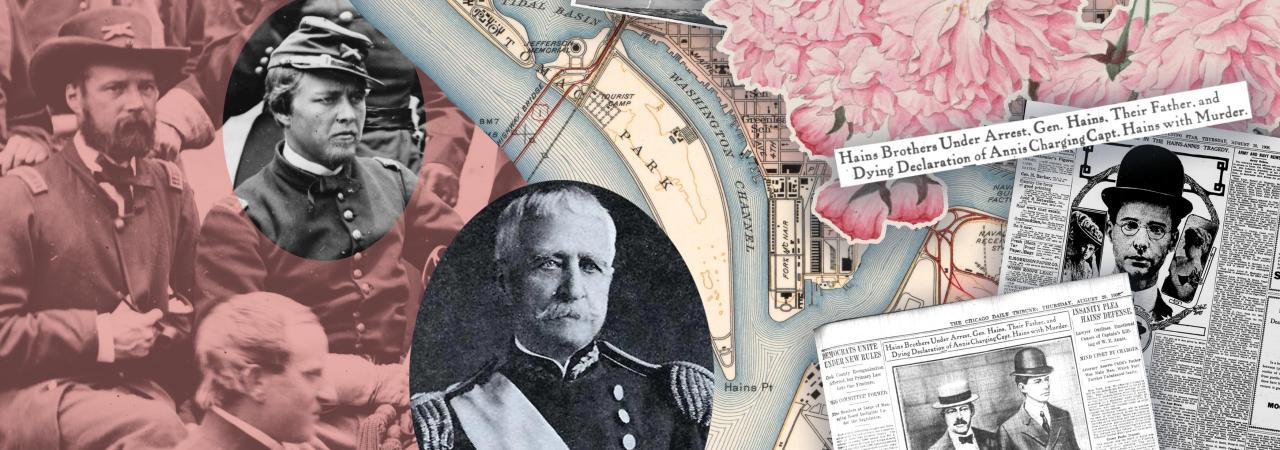Peter Conover Hains

Peter Conover Hains made history when he fired the first shot of the Battle of Bull Run. But over the course of his lifetime, Hains’s name would be linked to more than just the first land battle of the American Civil War. He served in the Spanish American War and retired in 1904, only to be called back during World War I. Even today, you can still see the evidence of his engineering skills along the east coast. His legacy also lives on through his sons and grandchildren through their service in the U.S. military and their headline-making antics.
Early Years and the Civil War
Peter Conover Hains was born on July 7, 1840, in Philadelphia, Pennsylvania. Appointed to the United States Military Academy at West Point, Hains attended classes with future Medal of Honor recipient Alonzo Cushing, as well as George Armstrong Custer. He graduated in June 1861, two months after the bombardment of Fort Sumter. Hains was commissioned a First lieutenant and assigned to the 2nd U.S. Artillery. Hains was given the honor and responsibility of firing the signal shot at the Battle of Bull Run. He eventually transferred to the US Army Corps of Engineers.
Hains’s major contribution to the Civil War came in 1863, during the Vicksburg Campaign. As Chief Engineer of the XIII Corps, he established earthworks surrounding the city, including locations with tunnels dug under Confederate lines. His work resulted in his promotion to the rank of captain. In 1911, a monument was dedicated to his service on the Vicksburg battlefield.
Engineering for the U.S.
Following the war, Hains served as the Engineer Secretary of the United States Lighthouse Board. He supervised construction of lighthouses at St. Augustine, Florida, and Morris Island, South Carolina. In 1881, a disastrous flood in Washington, D.C. forced the Army Corps of Engineers to come up with a solution for the drainage issue, as parts of the National Mall – and the White House! – were accessible only by boat. For nine years, Hains worked as the chief engineer on the rivers around Washington. He designed the Tidal Basin, still loved and visited by people today for its famous cherry trees. Hains Point, the popular D.C. destination for picnicking and other outdoor activities overlooking the Tidal Basin, is named in his honor. Hains also constructed Potomac Park and the George Washington Parkway.
Serving Through WWI
During the Spanish American War, Hains served as a brigadier general of U.S. volunteers and, later, on the Nicaragua Canal Board. Hains was promoted to brigadier general in the regular army on April 21, 1903, and retired the following year.
But the Army was not done with Brig. Gen. Hains! With the outbreak of World War I, Hains was recalled to active duty and served as the chief engineer for the Norfolk Harbor and River District. At age 76, he was the oldest officer in the U.S. Army. [No, he wasn’t the oldest person to serve as an officer. That distinction goes to Brevet Brigadier General John Walbach who died on active duty in 1857 at the age of 90.] General Hains passed away at Walter Reed Hospital on November 7, 1921, at the age of 81. He and his wife, Virginia Jenkins Hains, daughter of Admiral Thornton Jenkins, are buried at Arlington National Cemetery.
The Ensuing Generations
Later generations of Hainses also served in the U.S. military. Peter Conover Hains II attended the United States Naval Academy from 1891-1893, but did not graduate. John Power Hains attended West Point from 1885 to 1889. Thornton Jenkins Hains left school at the age of 12 and took to the sea as a cabin boy on the schooner Pharos. Thornton was a sea novelist who used the writings of his maternal grandfather and namesake, Admiral Jenkins, as well as his own travels, as inspiration.
…And Headline-Making Controversies
Although General Hains was well-known amongst the military community, his sons launched the family into the national spotlight in the early 1900s. On August 15, 1908, Peter Conover Hains Jr, an up-and-coming Army captain , brazenly shot William Annis, one of his closest friends and an editor and contributor at Harpers’ Weekly magazine.
Thornton J. Hains had written to his brother, claiming Peter’s wife was having an affair with Annis. Thornton accompanied Peter Jr. to the Bayside Yacht club, where the latter pulled the trigger on Annis in front of a crowd that included Annis’ wife and two children. The event, known as the “Murder at the Regatta,” made headlines across the country and turned into one of the most famous trials of its time. The proceedings saw one of the last major uses of the argument “Dementia Americana”, a psychological occurrence wherein American men become temporarily insane, long enough to enact violence on their wives’ lovers before returning to normal. Thornton pleaded not guilty on the grounds of insanity and was acquitted. Peter was convicted of manslaughter, but was later pardoned because of his father’s good standing.
The Hains Legacy of Service Lives On
The Hains family reputation was repaired with Peter Conover Hains III. A member of the West Point Class of 1924, he became an Army cavalry officer and competed in the 1928 Olympic Games. Hains led the First Armored Regiment in North Africa during World War II. During his service Hains received the Silver Star, Distinguished Service Medal, three Legions of Merit, Bronze Star with Oak Leaf Cluster, a Purple Heart and the Army Commendation Medal. Peter Conover Hains III and his wife are also buried at Arlington. Peter Hains, IV graduated from West Point in 1952 and retired as a Colonel. Hains’s great-great grandson John Power Hains, graduated in the West Point Class of 1983. Paul Hains, another great-great grandson, served in the Army National Guard.
The Hains family is just one instance of how ancestry research can reveal incredible stories and long legacies of military service. There are many other examples of families with rich military histories, covering multiple wars. What might you find out with a little research?
Ancestry.com has been helping people understand their ancestors and why they fought for causes large and small for decades. Now, we are thrilled to share an exclusive discount for all Trust members to subscribe to Fold3. Every Trust member receives a 25% discount on a premium subscription when they join or renew today.


